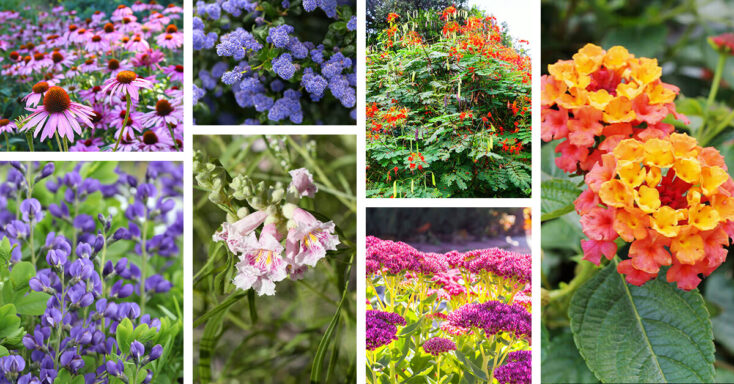Water is one of the most important aspects of establishing a successful garden – not to mention one of the most time-consuming. Many of the most beautiful and popular ornamental garden plants need regular watering, while some are fairly picky about when and how they’re watered: too little, or too often, and they’ll wilt; too much, or too often, and they’ll develop root rot or leaf spot.
If you live in a place with hot or dry summers (or both), you’re probably familiar with the struggle of keeping your plants happy when temperatures climb and precipitation drops. If you find that your garden looks brown by the end of summer, it doesn’t necessarily mean you’re not working hard enough – you might just be planting the wrong plants!
Drought-adapted gardens have become quite popular recently, as gardeners recognize the importance of reducing the resources their gardens need and the benefit of using plants adapted to their climate. You don’t have to sacrifice aesthetic appeal for drought resistance: many of the toughest, most resilient garden plants also happen to be the most beautiful!
Key Takeaways
- Although they’re often used interchangeably, “drought tolerance” and “drought resistance” aren’t the same thing. Drought-tolerant plants are adapted to temporary, often seasonal, water scarcity; drought-resistant plants, on the other hand, are adapted to chronic water restriction.
- Many drought-tolerant plants don’t actually grow well in dry areas, because they rely on seasonally plentiful water to stay alive. Drought-resistant plants, on the other hand, can get by on just a few inches of rain per year – but for that very reason, they’re highly susceptible to overwatering.
- Most drought-adapted garden plants have elements of drought tolerance and drought resistance – but that doesn’t mean that they will perform well in your particular garden. Depending on your climate (average high and low temperatures, seasonality of precipitation, and relative humidity) and your soil (primarily how well-drained it is), some plants will thrive, while others wither away.
- Don’t assume that just because a plant is described as “drought-resistant,” it won’t need any supplemental water. Most drought-resistant plants are still fairly vulnerable when young, or when first transplanted, but once their root systems develop, they’re quite robust.
- One important but often overlooked trait to look for in a drought-adapted plant is resistance to deer browsing (as well as rabbits and other herbivores). Even if your garden doesn’t normally attract much attention from deer, it will be a lot more enticing in a drought – and even more so if it’s the only green patch on the block.
- Keep in mind that most of the time, the plants that will perform best in your garden are the ones that are native to your area: they’re precision-engineered to your climate and even your soil, and usually resist pests and diseases better than exotic species.
- Finally, don’t get discouraged if your drought-adapted garden is struggling by summer’s end. Rather than fret over the failures, take note of which plants performed well, then take a cue from them and adapt!
Below, you’ll find 15 of the very hardiest, lowest-maintenance plants for drought-adapted gardens. You won’t find any cacti, yuccas, or succulents on this list: they can make excellent drought-adapted garden plants – but they’re obvious choices. This list is meant to show the diversity of drought-resilient plants, from ground covers to showy shrubs.
These plants will still look green and happy in August, with no (or very little) watering.
15 Drought-tolerant Plants that Look a Lot Less Thirstier than They Are
1. Purple Coneflower (Echinacea purpurea)
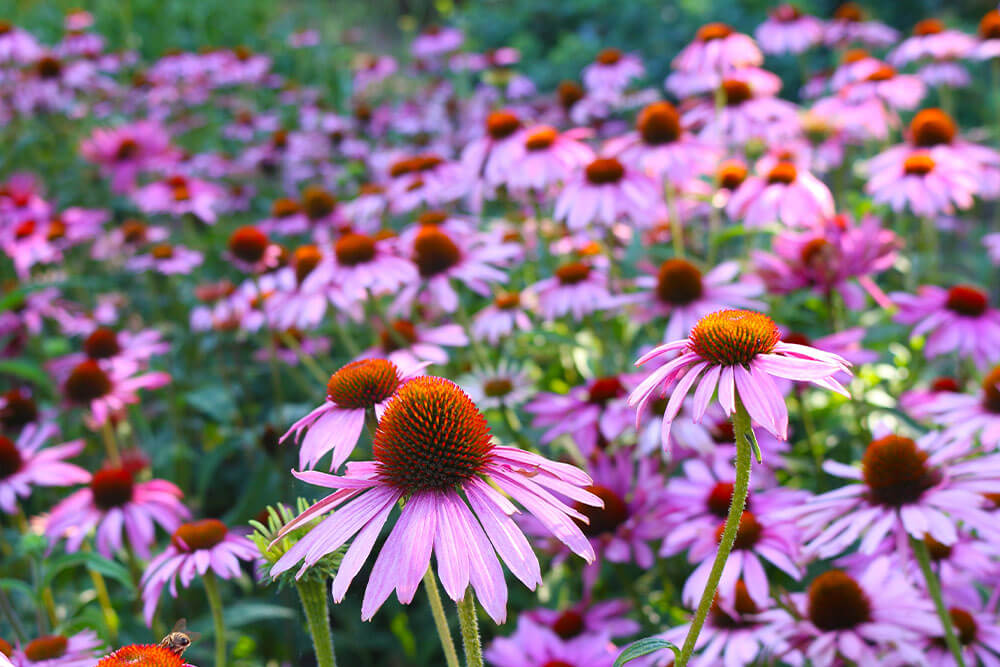
Purple coneflower is a garden workhorse, beloved by beginning gardeners and experts alike for its showy, long-lived flowers and easygoing temperament. This tough-yet-lovely native perennial grows wild in prairies and meadows from Texas to New England (zones 3 to 8), and it’s just as adaptable as that range suggests.
Drought, heat, and thin soils are no problem for purple coneflower – yet it grows just as well in clay soil and part shade. The genuine “plant it and forget it” is about as common as the proverbial free lunch — but purple coneflower is remarkably close to the real deal.
2. Artemisia (Powis Castle)

Named for the historic Welsh castle where it was first cultivated, ‘Powis Castle’ Artemisia has been called “one of the finest plants in cultivation.” One look at the finely-wrought, silvery foliage is enough to see why, but ‘Powis Castle’ also happens to be an uncommonly tough plant. This mounding, shrub-like perennial performs best in zones 6 to 9, where it thrives in full sun on dry, rocky soil that even a weed would disdain.
In fact, dry soil is less an obstacle for this plant than it is a positive requirement: slow drainage, humidity, and poor air circulation are all deal-breakers for ‘Powis Castle,’ but give it the right conditions and you’ll have a friend for life.
Give it room to grow, too: ‘Powis Castle’ likes to spread out, and a single plant can cover an area six feet wide or more, which makes it invaluable as a ground cover, border or accent.
3. Sage (Salvia spp.)
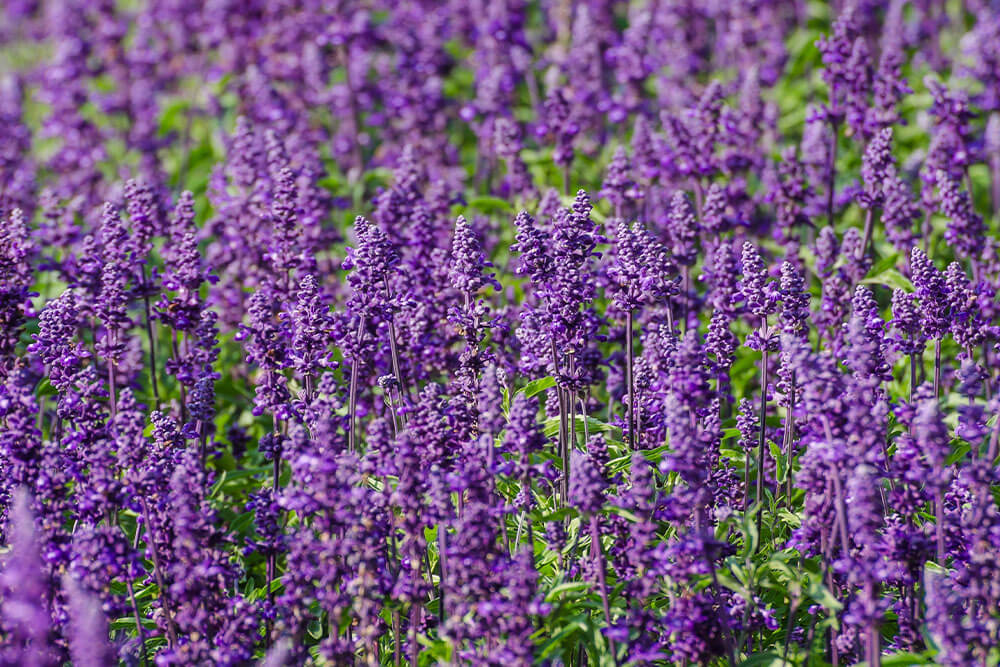
The genus Salvia is astoundingly diverse, boasting nearly a thousand species distributed all over the world. Most of them are native to drought-prone regions (Central America, the Mediterranean, and Western Asia), so gardeners looking for drought-adapted salvias are spoiled for choice (not to mention the countless ornamental hybrids).
Autumn sage (S. greggii) is a showy yet low-maintenance native, which handles heat and humidity quite well and blooms (contrary to its name) throughout the summer. Baby sage (S. microphylla) is even more drought-tolerant, and the two-toned ‘Hot Lips’ cultivar has become a popular choice in southern and southwestern gardens.
Of the exotic species, Russian sage (S. yangii) has gained wide popularity for its large size, generous flowers, and frost tolerance (to zone 4). One of the most drought-friendly sages around is actually a hybrid of two native species: ‘Indigo Spires’ (as well as its dwarf version, ‘Mystic Spires’).
4. Baptisia, False Indigo (Baptisia australis)
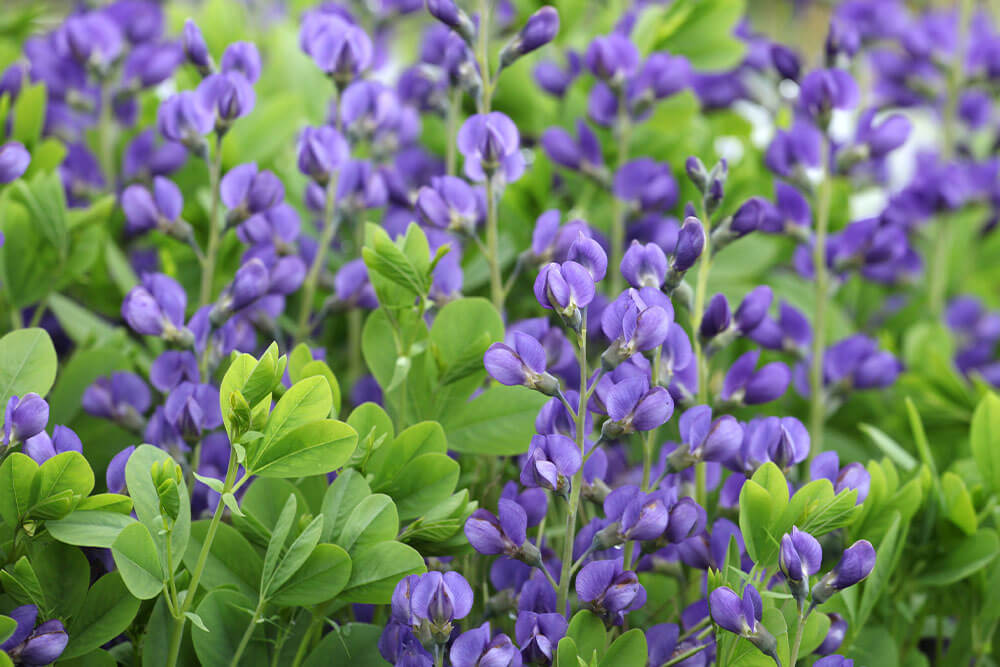
False indigo is a shrubby perennial native to the eastern United States, which has won admirers well outside its native range (it’s won the Royal Horticultural Society’s “Award of Garden Merit”). False indigo’s bushy habit and tall spikes of indigo flowers make it look a bit like a sage, but false indigo is actually in the legume family (Fabaceae).
Like many native legumes, it’s a specialist of dry, infertile soil, sending down deep roots that make it a great plant for preventing erosion on bare slopes — and harbor symbiotic bacteria that help fertilize the plant even in barren soil.
Not only is it impressively hardy (between zones 3 and 9), but its large and profuse blue flowers are quite showy, making a versatile mid-sized perennial for borders, naturalized gardens, and even ecological restoration.
5. Rattlesnake Master (Eryngium yuccifolium)
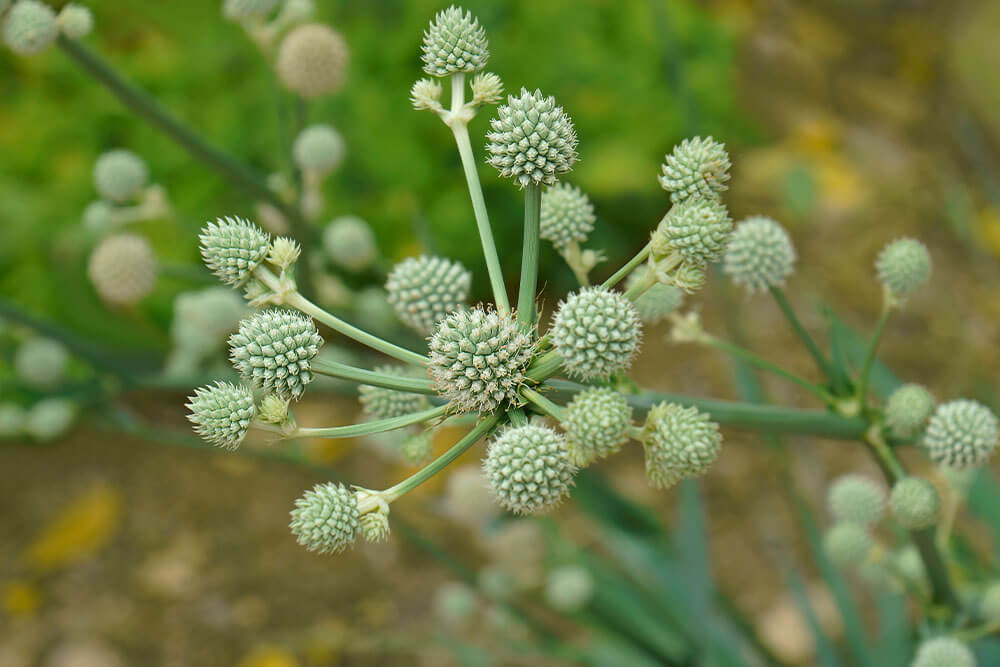
Rattlesnake master is a perennial in the carrot family (Apiaceae) native to prairies and open woodlands throughout the Great Plains and the Deep South. Everything about this plant grabs your attention, from its blade-like, toothy leaves to its spherical flower clusters, which are surprisingly fragrant (and attractive to pollinators).
Hardy between zones 3 and 9, rattlesnake master thrives on dry, rocky soil and tolerates part shade. Its unique appearance is best showcased in a naturalized meadow or woodland garden or as an accent among more orderly natives.
6. Alamo Vine (Merremia dissecta)

Alamo vine is in the same family as morning glories, and its big white blooms will certainly remind you of those showy climbers. This vigorous, native vine is known for growing in even the most adverse conditions, including drought, humidity, and infertile soil.
It’s a deciduous perennial south of zone 7, but its rapid growth rate makes it easy to grow as an annual further north. Alamo vine isn’t the type to be trained on a trellis – it’s more like aerial ground cover. Allowed room to expand (and preferably a fence or shed to climb on), its profuse flowers and textured foliage make a big impact.
7. Blueblossom, California Lilacs (Ceanothus thyrsiflorus)
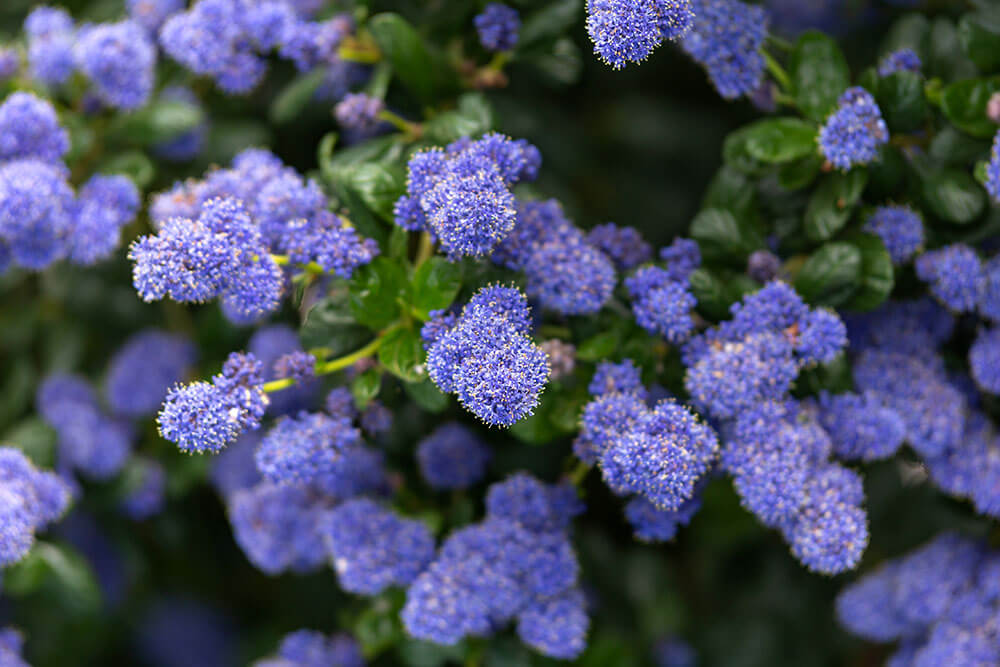
Ceanothus is a genus of tough, deep-rooted native shrubs that thrive in a wide range of conditions, from dry, rocky soil to shaded stream banks. Blueblossom (C. thyrsiflorus), sometimes called California lilacs, is the biggest and showiest of the numerous popular ornamental species.
Its blue-to-violet blooms more than justify the name, while its glossy, evergreen foliage has year-round appeal. Left to grow naturally, it can reach an impressive height and spread, but it’s easy to prune and can be maintained as a three-foot shrub in a border or hedge.
One thing blueblossom won’t tolerate is transplanting: once established, it can’t be moved without damaging the deep and extensive root system. For this reason, it’s best to treat it like a tree, whatever its actual size.
8. English Lavender (Lavandula angustifolia)
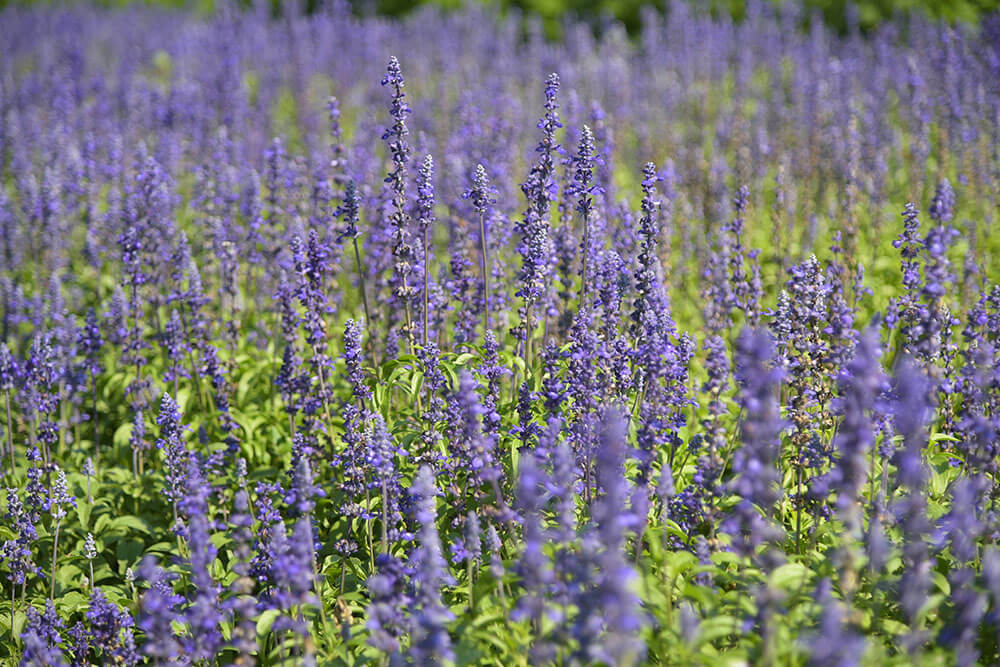
If you’ve only thought of lavender as an herb up to now, you’re really missing out: lavender’s purple blossoms, fine structure, and hardiness make it a fantastic garden plant that deserves much better than a corner of the kitchen garden.
A number of species of lavender have been used as ornamentals, but English lavender is the hardiest, perennial as far north as zone 5 (most other species will not survive the winter north of zone 8). It’s also exceptionally drought tolerant, and like Artemisia thrives on dry, barren soil where you might have given up trying to grow anything at all!
Lavender is an excellent border or edge plant, and its attractiveness to pollinators makes it a valuable companion plant for plants with edible fruits.
9. Stonecrop (Sedum)
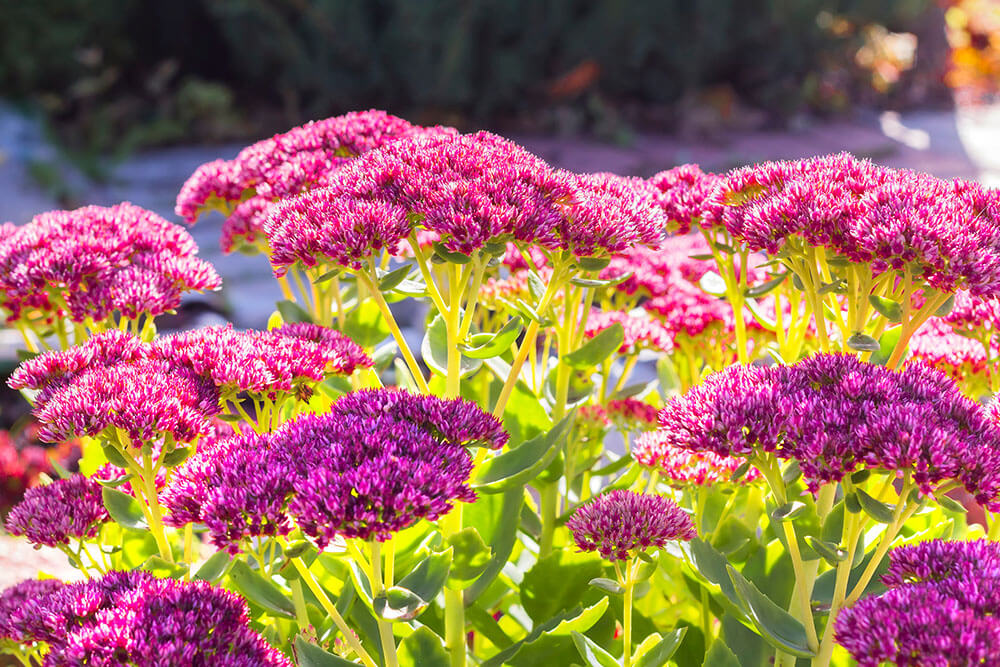
Stonecrop is named for its ability to colonize bare rock, forming a living carpet of succulent stems that in some species burst into colorful bloom. These plants are uniquely adapted to a life of heat and drought, and should be your first choice and last resort for thin, rocky soil. Recently, they’ve even come into vogue as green roofs, beautifying while they insulate!
While there are hundreds of species of Sedum, most fall into two main categories: tall and short. The latter are generally low-growing (sometimes just a few inches) but spreading, and are ideal ground covers for harsh or exposed areas.The former are more upright and generally have a more clumping or mounded shape. They can also be quite showy, producing large and colorful clusters of flowers that persist for a remarkably long time.
10. Blanket Flower (Gaillardia)

Blanket flower’s show-stopping red, orange, and yellow blooms are a delight to humans and wildlife alike, blooming all summer long even in the hottest, driest gardens. These short-lived but vigorous native perennials are favorites for large-scale landscapes like highway verges because they’re so easy to grow from seed, and because they tolerate drought, heat, and other adverse conditions with grace and ease.
In fact, you’ll find that once your plants are established, you can pretty much forget about them – at least until they start blooming again, in spring. Depending on the species, they can be grown as annuals or perennials between zones 3 and 8. Even if your plants don’t survive the winter, you may not notice: blanket flower self-seeds so prolifically that it comes back year after year!
11. Peacock Flower, Pride of Barbados (Caesalpinia pulcherrima)

Like its namesake, the flamboyant red-and-orange blooms of the peacock flower demand attention, both by their vibrant colors and their unique whisker-like stamens that can reach six inches long. In tropical climates, it’s a leggy, evergreen shrub or small tree, but is usually grown as a deciduous shrub (in zones 9 and up) or perennial (zone 8).
Despite its delicate appearance, it’s highly drought-resistant, though it benefits from an occasional deep watering in summer. It’s also seriously heat-tolerant, as well as deer-resistant thanks to its spiny stems. It makes an eye-catching anchor or specimen, but a few judiciously pruned plants can make a great hedge or screen, too.
12. Yarrow (Achillea spp.)
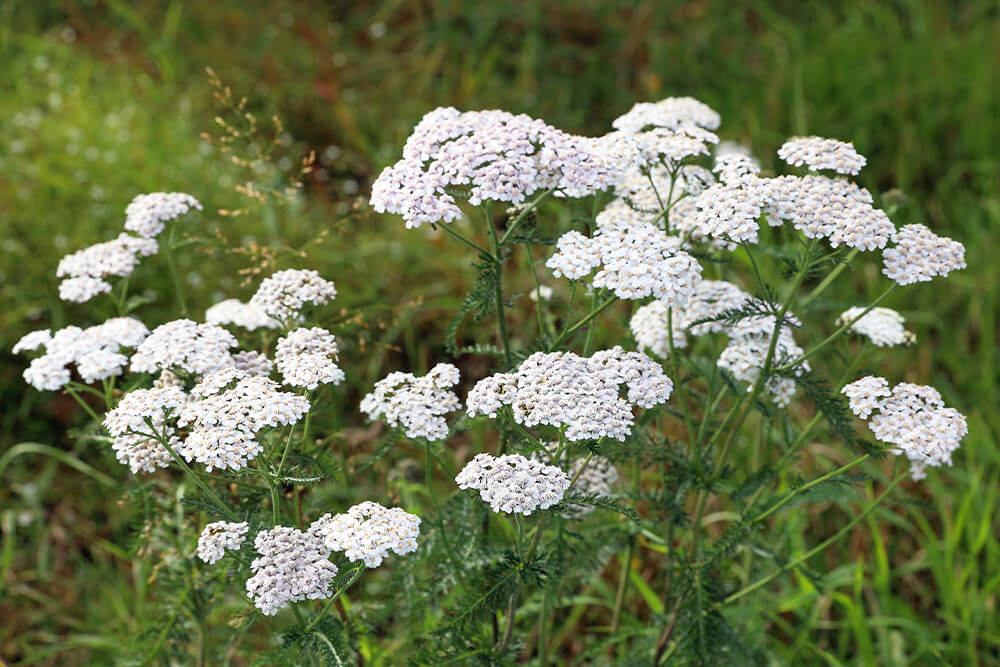
Yarrow is a classic summer-blooming perennial, sporting lacy clusters of white, yellow, or red flowers that bloom continuously from early spring to late fall. Just as beautiful as the flowers are the plant’s deeply compound, fern-like leaves. (The specific epithet of common yarrow, A. millefolium, means “a thousand leaves.”)
Yarrow is one of the most widely distributed plants on Earth, which is reflected in its hardiness: between zones 2 and 10 – essentially the entire continent! It’s a testament to yarrow’s stamina and adaptability: no garden is too dry, too hot, or too rocky for yarrow, and it’s both deer- and rabbit-resistant as well.
Its spreading growth habit makes it ideal for borders, mass plantings, and as a flowering ground cover.
13. Esperanza, Yellow Bells (Tecoma stans)
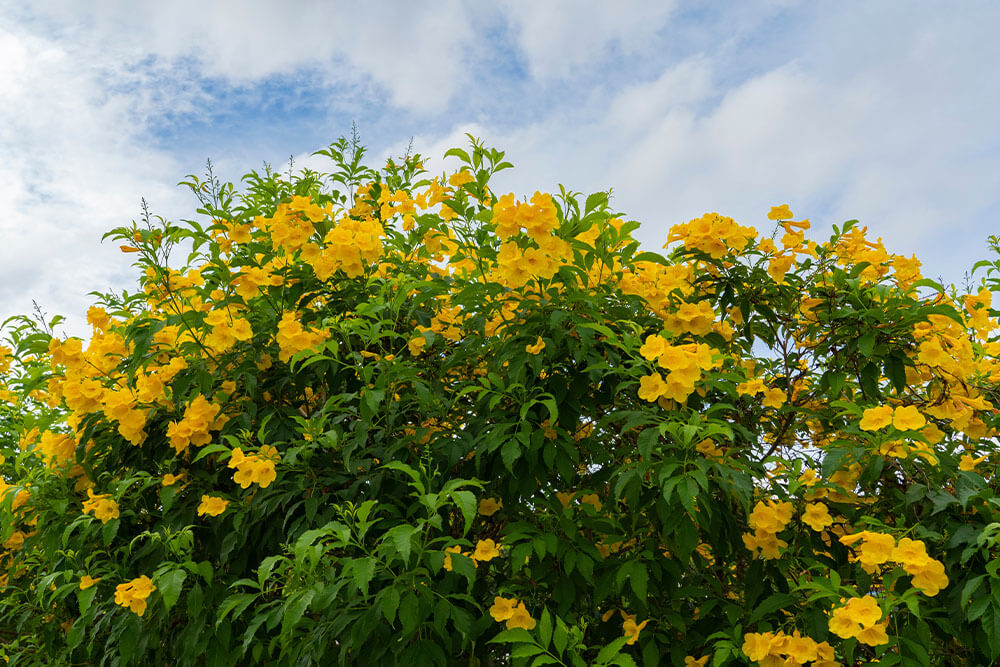
Yellow bells is a relative newcomer to the landscape trade, but has already won immense popularity with southern gardeners for its eponymous showy flowers, which bloom continuously throughout the summer, as well as its exceptional resistance to drought, heat and (especially) deer.
In zones 9 to 11, it grows as a deciduous shrub or perennial, and some varieties are frost hardy to zone 8, especially if mulched heavily in the fall. Northern gardeners don’t need to feel left out: yellow bells grows fast enough to be grown as an annual, and it takes equally well to containers.
14. Lantana (Lantana spp.)
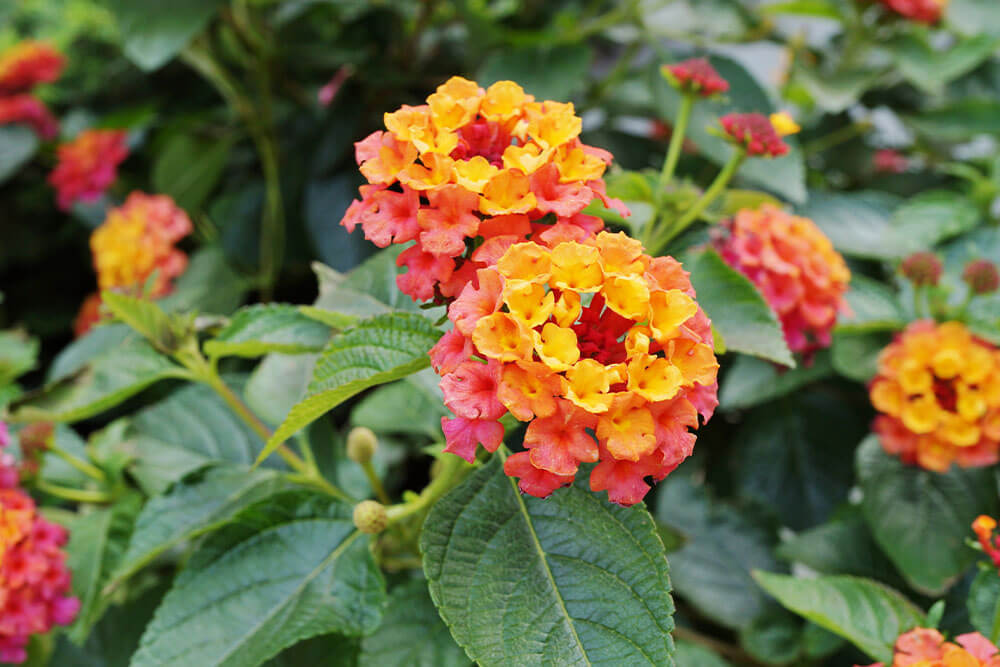
Lantana’s vibrant, multicolored flower clusters resemble miniature bouquets, adding a festive pop of color to the summer garden even when most perennials are visibly feeling the heat. These fast-growing shrubs have been beloved ornamentals since the 19th century, and countless cultivars and hybrids are available in a literal rainbow of colors.
Despite their whimsical blooms, lantanas are seriously tough plants, ideally suited for the heat, drought, and humidity of southern gardens. (In fact, two of the most common species are native to the region.) While a few varieties are perennial to zone 7, lantanas are fairly frost-tender – but they perform just as well as annuals, often reaching five feet high in a single growing season!
15. Desert Willow (Chilopsis linearis)
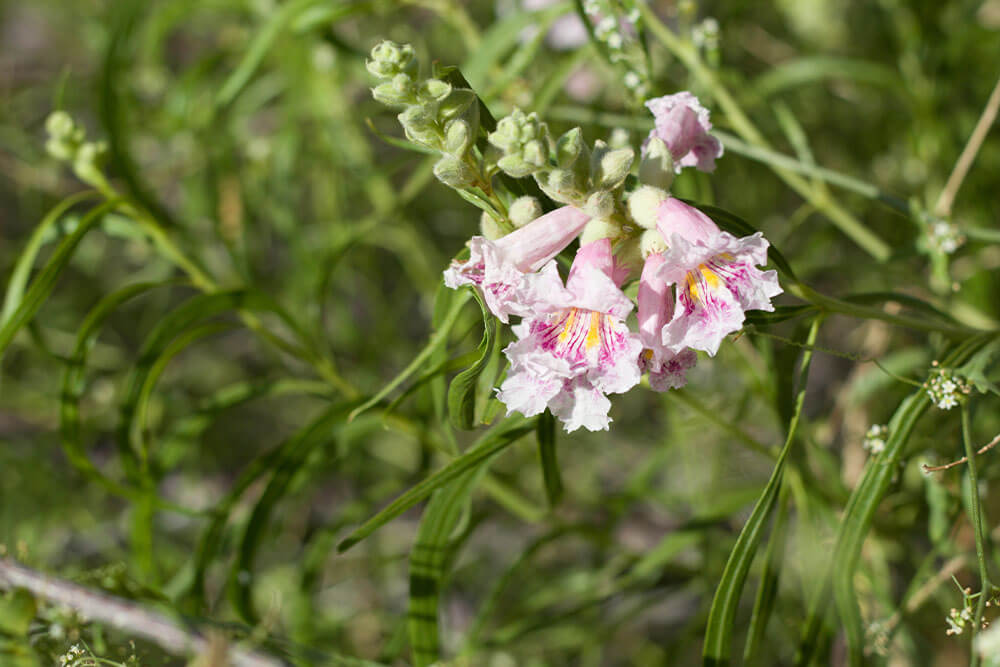
Desert willow isn’t really a willow; it’s a member of the catalpa family (Bignoniaceae), related to esperanza (above). Its narrow leaves and eccentric growth habit may remind you of its namesake, but you’ve never seen a willow with flowers like these: big, trumpet-shaped blooms in shades of pink and purple, attractive to humans, butterflies, and hummingbirds alike.
On the other hand, the “desert” part of the name is definitely accurate, as this shrub-sized tree thrives in the arid, inhospitable deserts of Arizona, New Mexico, and west Texas. Suffice to say, however dry your yard may be, desert willow can handle it.
This plant grows rapidly and takes well to pruning, so don’t be afraid to shape it. For a more shrub-like appearance, cut it back in the winter to encourage multiple stems, or let it grow unaltered for a more tree-like shape.
15 of the Most Drought-Resistant Plants (That Aren’t Cacti)
The plants above are just a few of the countless perennials that will still look fresh at the end of a hot, dry summer. Hopefully this list has demonstrated how much flexibility you’ll find among drought-resistant ornamentals, and maybe even provided some new names for your plant list. If not, don’t worry: there are so many drought-adapted perennials available today – from native species to exotic hybrids – that no list could ever hope to be complete.
Finally, remember that drought-adapted gardening doesn’t have to be all-or-nothing. Adding some drought-resistant foundation plants or borders can cut down dramatically on water use, freeing you up to focus on the plants you really want to keep.
Frequently Asked Questions About Drought-Tolerant Plants
What is the most drought-tolerant plant?
If we define a “drought-tolerant plant” as one that can survive in extremely dry environments, there are plenty of examples of species that can survive on as little as a few millimeters of rain per year — like creosote bush (Larrea tridentata), which thrives in the arid Mojave Desert.
There is an equally interesting group of plants that can survive almost complete loss of water and revive — sometimes years later — when rehydrated. These plants are sometimes called “resurrection plants”, and are of great interest to scientists. These are mostly mosses and ferns, like the common native resurrection fern (Pleopeltis). Resurrection fern can withstand near-total drying and remain alive, in a kind of suspended animation, for up to a century, returning to normal within hours of rehydration.
Flowering resurrection plants are much rarer, but there are a few, of which the best-known example might be Haberlea, or Orpheus flower. In the early 20th century, a botanist accidentally revived a plant that had been pressed, dried, and stored in a herbarium for three years!
Which plant can survive in extremely dry conditions?
Outside of Antarctica — which is too cold to support plant life year-round — the Earth’s driest places are actually quite diverse, and are prime habitat for countless species of plants known as xerophytes (xero- means “dry), because they don’t just survive periods of water scarcity but are positively at home in water-limited environments. Cacti, yuccas, and other succulents are the best-known xerophytes, but they’re far from the only ones.
One of the strangest xerophytes can be found in the Namib Desert, one of the driest places on Earth, where average annual precipitation is measured in millimeters rather than inches. It’s an extraordinarily odd-looking plant called Welwitschia mirabilis, and it’s one of the more mysterious xerophytes — not only because of its bizarre appearance, but because of its exotic adaptations to its environment: it has no stem and produces only two leaves its whole life — which nevertheless grow continuously for as long as the plant lives.
What is the meaning of drought tolerance?
Although they’re often used inconsistently, even by botanists, “drought tolerance,” “drought resistance,” and “drought avoidance”each have specific and distinct meanings. “Drought tolerance” refers to a plant’s ability to survive or recover from temporary drought, which means that it’s not really applicable to most plants we might think of when we hear the phrase — cacti, yuccas, acacias, etc. These plants grow in places where water is always scarce, and where the threshold for drought is much lower. Most drought-tolerant plants are actually from fairly wet climates, and a number of them are even found in rainforests.
Likewise, they are not mostly flowering plants, which have a lot of tools to prevent water loss. Instead, most are mosses and other simple plants that are almost the opposite of “drought-resistant”. These plants have no control over how quickly they lose water, and dry out extremely quickly — but they can lose nearly all the water in their tissues and remain alive (but dormant) for years or even decades.
Which plant lives in a dry habitat?
One of the largest and most diverse groups of drought-adapted plants is the grass family (Poaceae). While not all grasses are drought-resistant (or even drought-tolerant), grasses have primarily evolved and diversified in dry habitats. Think about it this way: forests, which cover about 30% of the Earth’s land area, comprise tens of thousands of species of trees from dozens of different families. Grasslands, which make up around 40% of the Earth’s land area, are all dominated by a single plant family. If grasses didn’t exist, much of this area — which is too dry to support trees, and often too dry even for shrubs — would likely be desert.
What plants need the most water to survive?
All plants need some water to survive, but plants that live in water are fairly rare. This might seem surprising, given that all land plants evolved from aquatic algae, but keep in mind that in the beginning, all plants were land plants. Aquatic plants had to re-adapt to the water, much like whales and dolphins — and it seems most plants actually prefer the land, even with The world’s “thirstiest” plants are eelgrasses, aquatic plants (not true grasses) in the genus Zostera. Unlike other aquatic plants, which either emerge from the water (like cattails) or float on its surface (like water lilies), eelgrass lives and reproduces entirely underwater.

